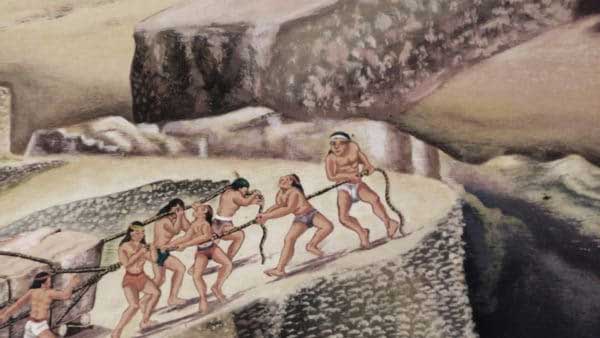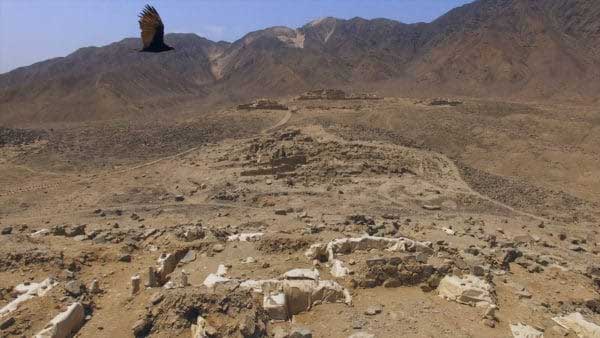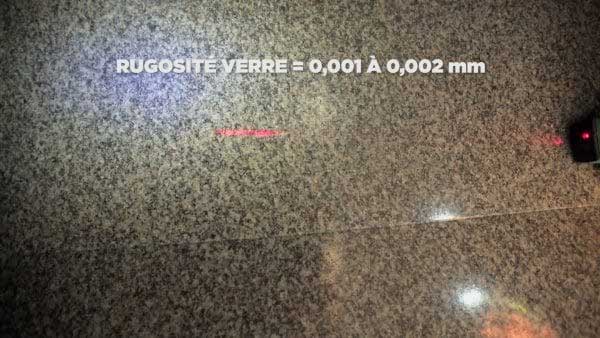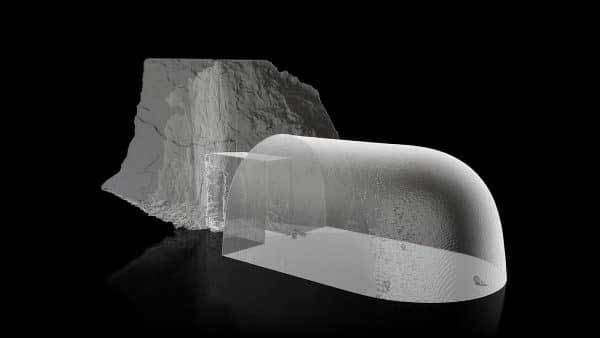BAM is more than a movie, it is an experience
BAM is an investigation into the origins of our civilization. The documentary will take you on a journey across space and time and offer you a closer look at our History and it will change everything you have believed in up to this point.
What is BAM?
BAM is an acronym for "Builders of the Ancient Mysteries", it is an investigation into our civilization a long time ago, which visits the greatest archaeological sites on our planet and will challenge you with our bold hypothesis.
BAM will seduce you with its beautiful cinematography and will make this an incredibly magical journey, you will travel back in time and space from the comfort of your livingroom. BAM will allow you to take a step back, it will force you to realise the importance of the events that our society has been going through for several decades and the unknown concerning our future. If you wonder what the link between ancient archaeological sites and the future of humankind may have in store. BAM will take you on a journey that sets out to explain the great achievements of our ancestors and the sheer beauty of the world they built. It will be an unforgettable experience that you will cherish forever.
The most famous sites of Easter Island, Peru (Cuzco, Sacsayhuaman, Ollantaytambo, Machu Picchu, Naupa Iglesia, Caral Supe, Nazca), Bolivia (Tiahuanaco, Puma Punku), Egypt (Luxor, Serapéum , Giza), Turkey (Gobekli Tepe), Greece (Antikythera Mechanism), Cambodia (Angkor Wat, Ta Phrom, Bayon) and India (Barabar, Mahabalipuram). Presented in a way that you have never seen before. Interviews with scientists and experts such as Érik Gonthier, prehistorian, semiologist, ethno-mineralogist and geologist at the Musée de l'Homme, Graham Hancock, journalist and researcher, Christopher Dunn, engineer and researcher, Mallku Aribalo, Historian of the Incas and Shaman. Yanis Bitsakis physicist, member of THE ANTIKHYTERA MECHANISM RESEARCH, Mathias Buttet engineer director of research and development of the Swiss company Hublot, Jean-Louis Boistel, Companion, medievalist and stonemason, Pascal Waringo Companion and specialist in medieval studies, Bleuette Diot, historian and researcher, Quentin Leplat, teacher and researcher, who will take you on an extraordinary journey through time, to the edge of the origins of our civilization.
The most famous sites of Easter Island, Peru (Cuzco, Sacsayhuaman, Ollantaytambo, Machu Picchu, Naupa Iglesia, Caral Supe, Nazca), Bolivia (Tiahuanaco, Puma Punku), Egypt (Luxor, Serapéum , Giza), Turkey (Gobekli Tepe), Greece (Antikythera Mechanism), Cambodia (Angkor Wat, Ta Phrom, Bayon) and India (Barabar, Mahabalipuram). Presented in a way that you have never seen before. Interviews with scientists and experts such as Érik Gonthier, prehistorian, semiologist, ethno-mineralogist and geologist at the Musée de l'Homme, Graham Hancock, journalist and researcher, Christopher Dunn, engineer and researcher, Mallku Aribalo, Historian of the Incas and Shaman. Yanis Bitsakis physicist, member of THE ANTIKHYTERA MECHANISM RESEARCH, Mathias Buttet engineer director of research and development of the Swiss company Hublot, Jean-Louis Boistel, Companion, medievalist and stonemason, Pascal Waringo Companion and specialist in medieval studies, Bleuette Diot, historian and researcher, Quentin Leplat, teacher and researcher, who will take you on an extraordinary journey through time, to the edge of the origins of our civilization.
BAM offers a new approach, completely independent from an often too assertive historical shackle. These historical claims lack conclusive evidence. The powers that be rather than discuss our findings they disparage it and oppose anything new that may come from advanced scientific research. The question is why? May it be because if we are right, they will need to rewrite all history books?


Different paths lead to BAM
You may have heard of BAM from different places. It may have been an enthusiastic colleague or friend, who confided in you that they couldn't sleep after having seen it, the film raised so many questions and awakened deep feelings.
It could also have been an academic specializing in archaeology or Egyptology, more than likely on the Internet. By an individual presenting themselves as an annoyed 'sceptical rationalist'. Namesayers of the 'charlatans', 'pyramidiots" or even 'intellectual crook'. The hypothesis defended by the film will probably be compared to the 'people who believe in extraterrestrials' and immediately placed in the intellectual area of lawlessness in which is all that is marginalized by the media.
The third, rarer, by a "neutral" person, who will offer to watch the film and discuss it calmly afterwards, simply because "certain things deserve an explanation". Achieving this neutrality marks a great deal of openness because every human being needs to believe in something in the face of lack of a clear explanation, in particular when speaking about "the great mystery of life". Whether it is a matter of believing in chance or in a 'higher power'. The most rational attitude possible towards belief should be "I don't know".
It could also have been an academic specializing in archaeology or Egyptology, more than likely on the Internet. By an individual presenting themselves as an annoyed 'sceptical rationalist'. Namesayers of the 'charlatans', 'pyramidiots" or even 'intellectual crook'. The hypothesis defended by the film will probably be compared to the 'people who believe in extraterrestrials' and immediately placed in the intellectual area of lawlessness in which is all that is marginalized by the media.
The third, rarer, by a "neutral" person, who will offer to watch the film and discuss it calmly afterwards, simply because "certain things deserve an explanation". Achieving this neutrality marks a great deal of openness because every human being needs to believe in something in the face of lack of a clear explanation, in particular when speaking about "the great mystery of life". Whether it is a matter of believing in chance or in a 'higher power'. The most rational attitude possible towards belief should be "I don't know".
BAM does not bring truths, but offers you to consider this subject differently, from a more technical angle: as you will be able to see, the puzzles posed by these archaeological sites take on a whole different glow.

Natural scepticism
It is perfectly normal to be sceptical about the question posed by this film: "What if we were not the first advanced civilization on Earth? The evidence is that it's impossible.
How can laymen afford to challenge the assumptions of scientists who have dedicated their lives to the subject? And then, if it were true, it would be known: science would talk about it and we would see it in academic archaeological documentaries. Presently, this is not believed to be true by Egyptology and by archaeology.
While the general public still situates human sedentarization in the time of the Sumerians, around 8,000 years ago, for archaeology, Homo Sapiens would now have settled down almost 11/12,000 years ago - a figure which has retreated 4,000 years following the discovery of the intriguing Gobekli Tepe site, voluntarily buried around 11,500 years ago. Humans would then have evolved in a linear fashion, going from cut flint to current nanotechnology. So there is no room for a technically very advanced civilization in this scheme, where enigmatic constructions, such as the great pyramid of Giza or the breathtaking caves of Barabar, were necessarily made with rudimentary tools.
However, this is what frees the gaze and frees itself from a form of conditioning due to the historical shackles and the grip of the knowledge accumulated by the predecessors, difficult to question and this, especially in Egyptology. In science, a distinction is made between the so-called 'hard' and 'soft' sciences. The hard sciences are based on experimental protocols and are based on reproducible and measurable facts: the results are indisputable.
Soft sciences (psychology, history, etc.) have a 'hard science' part. The 'soft' part is based on interpretation. It is the ratio between the two that is delicate. We believe that too much emphasis is put on history at the expense of factual science. This is why BAM's approach is vital to us. If tomorrow you decided to have a pyramid built, you would not call on a historian but on an architect and a qualified company: this is what BAM does. It tries to understand, because if the technical means and methods have changed over time, the thought of an architect or an engineer remains strictly the same, especially in the face of majestic and permanent buildings that have survived the test of time and other major destructive events like earthquakes.
There is no record that mentions the construction of the Great Pyramid of Giza before herodotus around 500BC. More than 2000 years after the supposed date of construction mandated by Egyptologysts. So therefore everything that is reported to us on this subject, which has varied widely over the past century, is to be taken in the conditional tense. But it turns out that when you dare to question it, you are immediately attacked or torn down! But year after year, more and more scientists, engineers and technicians have rallied to this technical prism of reading these ancient achievements.
How can laymen afford to challenge the assumptions of scientists who have dedicated their lives to the subject? And then, if it were true, it would be known: science would talk about it and we would see it in academic archaeological documentaries. Presently, this is not believed to be true by Egyptology and by archaeology.
While the general public still situates human sedentarization in the time of the Sumerians, around 8,000 years ago, for archaeology, Homo Sapiens would now have settled down almost 11/12,000 years ago - a figure which has retreated 4,000 years following the discovery of the intriguing Gobekli Tepe site, voluntarily buried around 11,500 years ago. Humans would then have evolved in a linear fashion, going from cut flint to current nanotechnology. So there is no room for a technically very advanced civilization in this scheme, where enigmatic constructions, such as the great pyramid of Giza or the breathtaking caves of Barabar, were necessarily made with rudimentary tools.
However, this is what frees the gaze and frees itself from a form of conditioning due to the historical shackles and the grip of the knowledge accumulated by the predecessors, difficult to question and this, especially in Egyptology. In science, a distinction is made between the so-called 'hard' and 'soft' sciences. The hard sciences are based on experimental protocols and are based on reproducible and measurable facts: the results are indisputable.
Soft sciences (psychology, history, etc.) have a 'hard science' part. The 'soft' part is based on interpretation. It is the ratio between the two that is delicate. We believe that too much emphasis is put on history at the expense of factual science. This is why BAM's approach is vital to us. If tomorrow you decided to have a pyramid built, you would not call on a historian but on an architect and a qualified company: this is what BAM does. It tries to understand, because if the technical means and methods have changed over time, the thought of an architect or an engineer remains strictly the same, especially in the face of majestic and permanent buildings that have survived the test of time and other major destructive events like earthquakes.
There is no record that mentions the construction of the Great Pyramid of Giza before herodotus around 500BC. More than 2000 years after the supposed date of construction mandated by Egyptologysts. So therefore everything that is reported to us on this subject, which has varied widely over the past century, is to be taken in the conditional tense. But it turns out that when you dare to question it, you are immediately attacked or torn down! But year after year, more and more scientists, engineers and technicians have rallied to this technical prism of reading these ancient achievements.
Technical vs Historical
The approach developed in the film is purely technical: faced with an apparent anachronism - the oldest stone blocks are the largest and they are arranged in the best order and fit perfectly - faced with architectural prowess and technical and artistic similarities and independent of historical constraints. BAM wonders about the possibility of a source of common knowledge and techniques, coming from an ancient human civilization which would have been destroyed during a cataclysm which occurred at a period called 'Dryas Recent'.
During this geological episode which occurred around 12,800 years ago, the global temperature dropped sharply by 7 °C and remained at this level for 1,300 years. Then suddenly rose by 10 °C. An event which would have been preserved by 'Humanity in its founding texts, myths and legends, while it has been forgotten by history.
Controversy surrounds the possible causes of the Recent Dryas. To really understand this, new scientific studies come to propose the following possibilities: "the impact hypothesis", it proposes that the entry into the Recent Dryas would be due to the various impacts of fragments of a comet (for example: Sedimentary record from Patagonia, southern Chile supports cosmic-impact triggering burning of biomass, climate change, and megafaunal extinctions at 12.8 ka)
In his latest book “America Before”, the journalist and researcher Graham Hancock sheds even more light on this episode by reviewing what could be the epicenter of this cataclysm. America, since we know very little about ancient history in this country. BAM goes into detail on the Great Pyramid of Giza but it also tackles many lesser known sites and subject matters. For example, the caves of Barabar in India, which we scanned in 3D and in which the surfaces we measured using a roughness meter: the results are incredible, an accuracy of between 2 and 5 mm and the smoothness of the walls equals that of glass. This is in a material that is harder than steel...granite.
Precise volumes which suggest the use of sound frequencies for a specific purpose: which one?
During this geological episode which occurred around 12,800 years ago, the global temperature dropped sharply by 7 °C and remained at this level for 1,300 years. Then suddenly rose by 10 °C. An event which would have been preserved by 'Humanity in its founding texts, myths and legends, while it has been forgotten by history.
Controversy surrounds the possible causes of the Recent Dryas. To really understand this, new scientific studies come to propose the following possibilities: "the impact hypothesis", it proposes that the entry into the Recent Dryas would be due to the various impacts of fragments of a comet (for example: Sedimentary record from Patagonia, southern Chile supports cosmic-impact triggering burning of biomass, climate change, and megafaunal extinctions at 12.8 ka)
In his latest book “America Before”, the journalist and researcher Graham Hancock sheds even more light on this episode by reviewing what could be the epicenter of this cataclysm. America, since we know very little about ancient history in this country. BAM goes into detail on the Great Pyramid of Giza but it also tackles many lesser known sites and subject matters. For example, the caves of Barabar in India, which we scanned in 3D and in which the surfaces we measured using a roughness meter: the results are incredible, an accuracy of between 2 and 5 mm and the smoothness of the walls equals that of glass. This is in a material that is harder than steel...granite.
Precise volumes which suggest the use of sound frequencies for a specific purpose: which one?


According to archaeologists, these caves are the oldest in India.
This is precisely what poses a problem: since the precision by which they builts these caves will never again be duplicated in the following centuries. How is it possible that while we progress technically we could never achieve the same results. These architects have masterpieces as their very first works. No errors, no faults, just absolute perfection to the mm. We would find it hard to reproduce these achievements today with today's technology.
Nobody took the time to investigate these caves before. King Ashoka offered them to a group of ascetics who didn't care about music and songs, it is therefore assumed that 'any sound properties of these caves could only be by mere accident'.
This is precisely what poses a problem: since the precision by which they builts these caves will never again be duplicated in the following centuries. How is it possible that while we progress technically we could never achieve the same results. These architects have masterpieces as their very first works. No errors, no faults, just absolute perfection to the mm. We would find it hard to reproduce these achievements today with today's technology.
Nobody took the time to investigate these caves before. King Ashoka offered them to a group of ascetics who didn't care about music and songs, it is therefore assumed that 'any sound properties of these caves could only be by mere accident'.

